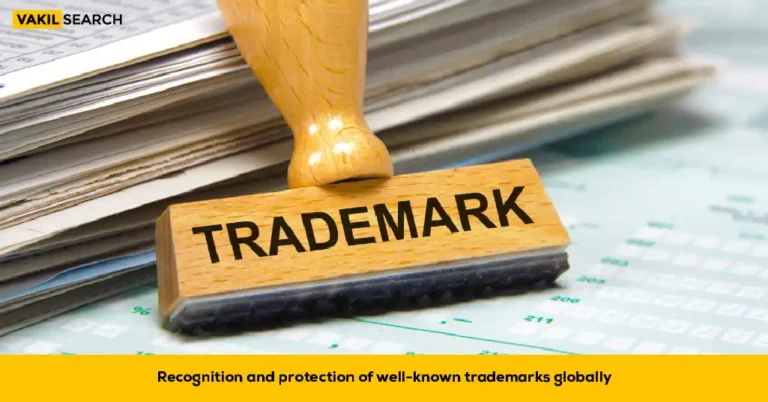Discover the fundamental steps to successfully register your trademark. From conducting a comprehensive search to filing the application and beyond, learn the four key stages of trademark registration in this concise blog.
Importance of Trademark
A trademark is a special symbol or combination of letters and numbers that a company uses to distinguish its products or services from others in the market. By registering a trademark, a business can prevent competitors and others from copying its offerings. In today’s business world, where building a strong brand and investing heavily in marketing are common practices, trademark registration is a crucial step to protect a company’s investment and ensure its efforts aren’t undermined by unscrupulous imitators. In this blog, we’ll dive into the details of the four steps to register the trademark process and explore the various types of trademarks. We’ll also take an in-depth look at the validity and significance of having a registered trademark, shedding light on why it’s a vital asset for businesses looking to secure their unique identity and reputation in the market.
Four Steps to Register the Trademark
Step 1: Conduct a Comprehensive Trademark Search
Before you start the formal trademark registration process, it’s essential to conduct a thorough trademark search. This initial step is crucial because it helps you determine whether your desired trademark is available for registration and whether it is likely to encounter any conflicts with existing trademarks. Here’s how to conduct a comprehensive trademark search:
1. Online Database Searches:
Start with the Indian Trademark Office’s Website: The official website of the Controller General of Patents, Designs, and Trademarks (CGPDTM) provides an online database of registered trademarks. You can access it at http://www.ipindia.nic.in/.
Use Professional Search Tools: Consider using professional trademark search tools or services to conduct an extensive search. These tools can help you identify potential conflicts and similar trademarks more effectively.
2. Consult a Trademark Attorney:
Hire a Trademark Attorney: Enlisting the services of a trademark attorney or a legal expert specialising in trademark law can be invaluable. They have access to specialised databases and expertise in conducting in-depth searches.
3. Review Trademark Classes:
Understand Trademark Classes: Familiarise yourself with the Nice Classification of Goods and Services, which categorises products and services into different classes. Determine the class or classes that are relevant to your business and trademark.
4. Analyse Search Results:
Review Search Results: Examine the search results for potential conflicts or trademarks that are too similar to yours. If your proposed trademark is already registered for similar goods or services, it may be challenging to proceed with registration.
Step 2: Prepare and File Your Trademark Application
Once you’ve conducted a comprehensive trademark search and ensured that your desired trademark is available for registration, it’s time to prepare and file your trademark application. Here’s how to go about it:
- Determine Your Trademark Format:
Choose the Format: Decide on the format of your trademark, whether it’s a wordmark (text), logo, combined logo and wordmark, or a three-dimensional mark. Be specific about the visual elements and wording.
2. Complete the Application Form:
Fill Out the Application Form: Visit the official website of the Indian Trademark Office (http://www.ipindia.nic.in/) and fill out the relevant trademark application form. You will need to provide details about your business, the trademark, and the classes of goods or services.
3. Include Required Documents:
Submit Required Documents: Attach any necessary documents, such as a specimen of the trademark (if applicable) and proof of address and identity. Ensure that all documents are in the prescribed format.
4. Pay the Application Fee:
Pay the Application Fee: Pay the government fee for trademark registration, which can vary depending on your entity type (individual, startup, MSME, or others) and the number of classes you’re registering for.
5. Submit Your Application:
Submit Your Application: After completing the form and paying the fee, submit your application electronically through the online portal. Make sure to retain the acknowledgment receipt and application number for future reference.
Step 3: Trademark Examination and Response
After submitting your trademark application, it undergoes a rigorous examination process by the Trademark Registry. Here’s what happens during this phase:
a. Examination by the Trademark Registry:
Examination Process: The Trademark Registry reviews your application to ensure it complies with legal requirements. They will check for any conflicts with existing trademarks, whether your trademark is descriptive or generic, and whether it falls under prohibited categories.
b. Issuance of Examination Report:
Examination Report: If the Trademark Registry finds any issues with your application, they will issue an Examination Report. This report may include objections or requests for clarifications.
c. Respond to Examination Report:
Respond to Objections: You must respond to any objections or concerns raised in the Examination Report within the stipulated timeframe, typically within 30 days. Seek legal advice if necessary to address the objections effectively.
d. Examination Report Finalisation:
Final Decision: Once the Trademark Registry is satisfied with your responses and any necessary amendments, they will either accept your application for publication or reject it. If accepted, your trademark will proceed to the next phase.
Step 4: Publication and Registration
The final step in the trademark registration process in India involves the publication of your trademark and its eventual registration. Here’s how it unfolds:
a. Publication in Trademark Journal:
Publication: If your application is accepted, your trademark details will be published in the Trademark Journal. This publication allows interested parties to oppose your trademark registration within a specified period (typically 3-4 months).
b. Opposition Period:
Opposition: During the opposition period, third parties or competitors may file objections if they believe your trademark registration may infringe upon their rights or if there are other valid reasons for opposition.
c. Registration Certificate:
Registration Certificate: If no valid oppositions are filed during the opposition period, the Registrar will issue a Registration Certificate for your trademark. This certificate grants you exclusive rights to use the trademark for the specified goods or services.
d. Renewal and Protection:
Renewal: Trademarks in India are initially registered for ten years, and you can renew them indefinitely by paying renewal fees. Ensure that you protect and enforce your trademark rights against any potential infringements.
By following these four essential steps, you can successfully navigate the trademark registration process in India. Remember that trademark registration provides legal protection for your brand and intellectual property, helping you build trust with customers and secure your market presence.
In conclusion, trademark registration is a crucial aspect of brand protection and legal compliance for businesses in India. It’s a process that demands attention to detail, compliance with legal requirements, and, often, the expertise of legal professionals. By understanding and following these four steps to register the trademark, you can effectively protect your brand and its unique identity in the Indian marketplace
FAQs on Four Steps to Register the Trademark
Why is trademark registration important for businesses?
Trademark registration is vital for protecting a company's brand identity and preventing others from using similar marks.
How long does trademark registration take, and is it complicated?
It takes several months to a year or more, and the process can be complex due to legal requirements.
Can any symbol or phrase be trademarked?
To be trademarked, symbols or phrases must be distinctive and non-generic, without infringing on existing trademarks.
What if someone uses an unregistered trademark?
Using an unregistered trademark may lead to legal disputes and challenges by other businesses.
Is trademark registration valid indefinitely?
No, trademark registration in India is initially valid for ten years and can be renewed indefinitely through payment of renewal fees.










